Neurotech monthly. June 2023
Transparent skull prosthetic and other frontier imaging tech, foundation models for image and video reconstruction, two neurotech market maps, a rare neurotech M&A, & EEG startups raising capital
Hello!
After almost two years, I’m back with the newsletter. The fourth issue of the astrocyte* is here. Among other things, it covers:
Neurotech reading list
- Hardware: Getting fUSI through the skull bone without losing sensitivity and a compact CW-fNIRS system;
- Data Science - DL for visual prosthetics, GPT for reconstructing context around a conversation, diffusion models for EEG, fMRI for image/video reconstruction, etc.;
- Business - neurotech market maps from the community and investors.
Startup/Corporate news
- Investments: four EEG-powered startups raised early rounds. On the invasive side - Paradromics and Neuralink raised later-stage rounds;
- A rare merger/acquisition happens between MindMaze and Babylon Health.
My interpretations/comments are marked as ‘Peter Zhegin’.
📬📬📬 Subscribe for a monthly update on neurotech and neurotech investment/commercialisation activity.
Thanks!
Subscribe
I. Reading List
Techstack/Hardware
fUSI presents a host of benefits (e.g., increased sensitivity, resolution, and portability) relative to more established techniques such as fMRI. However, fUSI cannot penetrate human skull bone while maintaining sufficient sensitivity. In this study, we established, for the first time, the feasibility of awake human fUSI imaging in a non-surgical setting through a polymeric acoustic window.
Peter Zhegin: It’s a great example of combining multiple technologies to reach the end goal. It is also a very entrepreneurial approach to understanding the limits of a product/tech and tweaking with variables that are possible to change. If you are stuck as a founder, try to look at a challenge from another perspective. E.g. ultrasound does not go through a surface - let’s change the surface, not the modality.
Here is how it works:
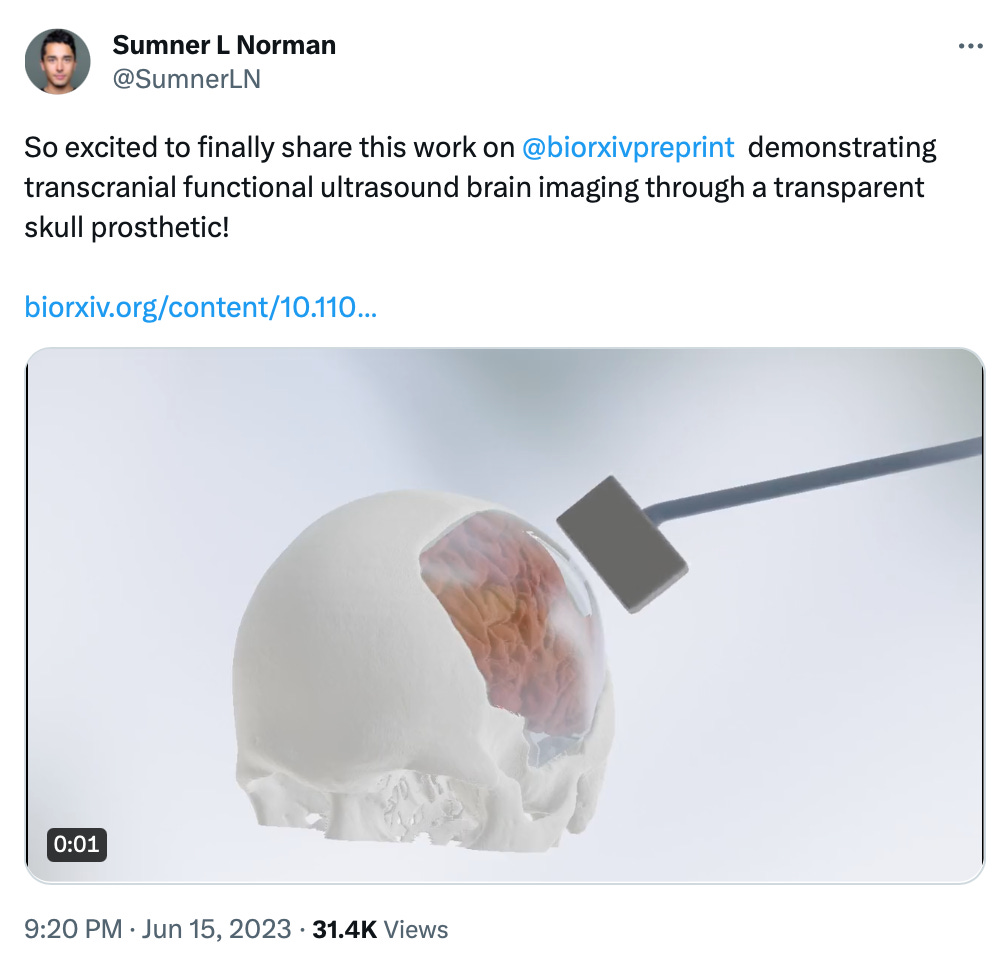
Scalable, modular continuous wave functional near-infrared spectroscopy system (Spotlight)
We present a CW-fNIRS system, “Spotlight,” composed of compact modular arrays of 39 detectors and 41 dual-wavelength NIR light-emitting diode (LED) sources (680 and 850 nm), with 6.5 mm interoptode spacing. Our system achieves optode number, density, and SNR similar to current state-of-the-art in HD-DOT in an easy-to-use portable form factor by combining advances in silicon photomultiplier (SiPM) detectors, flexible printed circuit board (FPCB) fabrication, optical ferrule design, customized 3D cap printing, and modular design approaches.
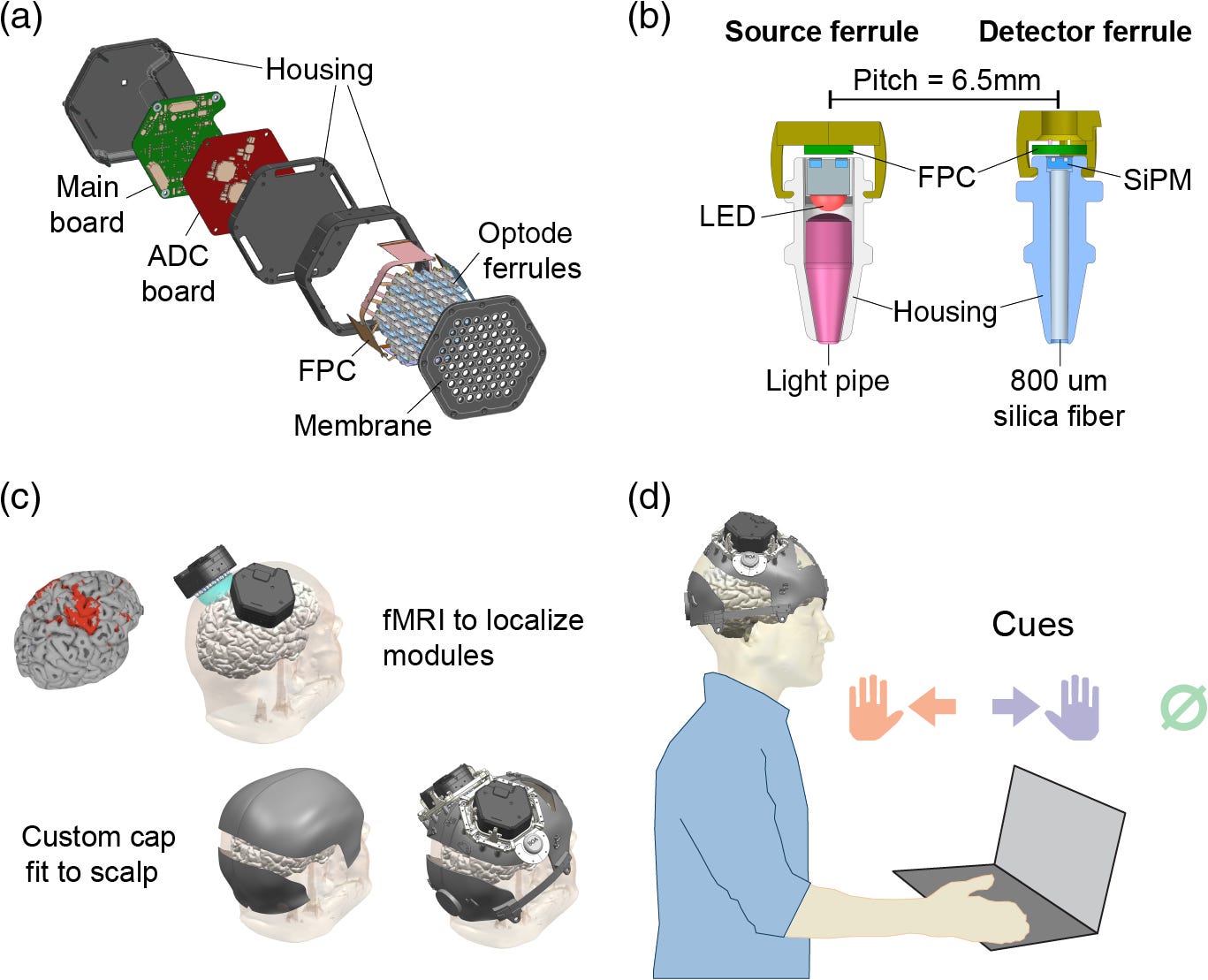
Peter Zhegin: Interesting to compare to probably the most famous fNIRS - Kernel’s TD-fNIRS that aims to compete with much broader adopted CW systems. Here is a paper on Kernel
Data Science
Human-in-the-Loop Optimization for Deep Stimulus Encoding in Visual Prostheses
Neuroprostheses show potential in restoring lost sensory function and enhancing human capabilities, but the sensations produced by current devices often seem unnatural or distorted (due to placements of implants and differences in individual perception). DL and Bayesian optimisation used for improved encoding and patient-specific simulation provide better perceptual experience of patients fitted with visual prostheses.
Peter Zhegin: This is an exciting direction for ML/DL startups to look at. Customisation was the cornerstone of previous technological revolutions, and any consumer adoption of wearable neurotech/BCIs will need to make them customisable.
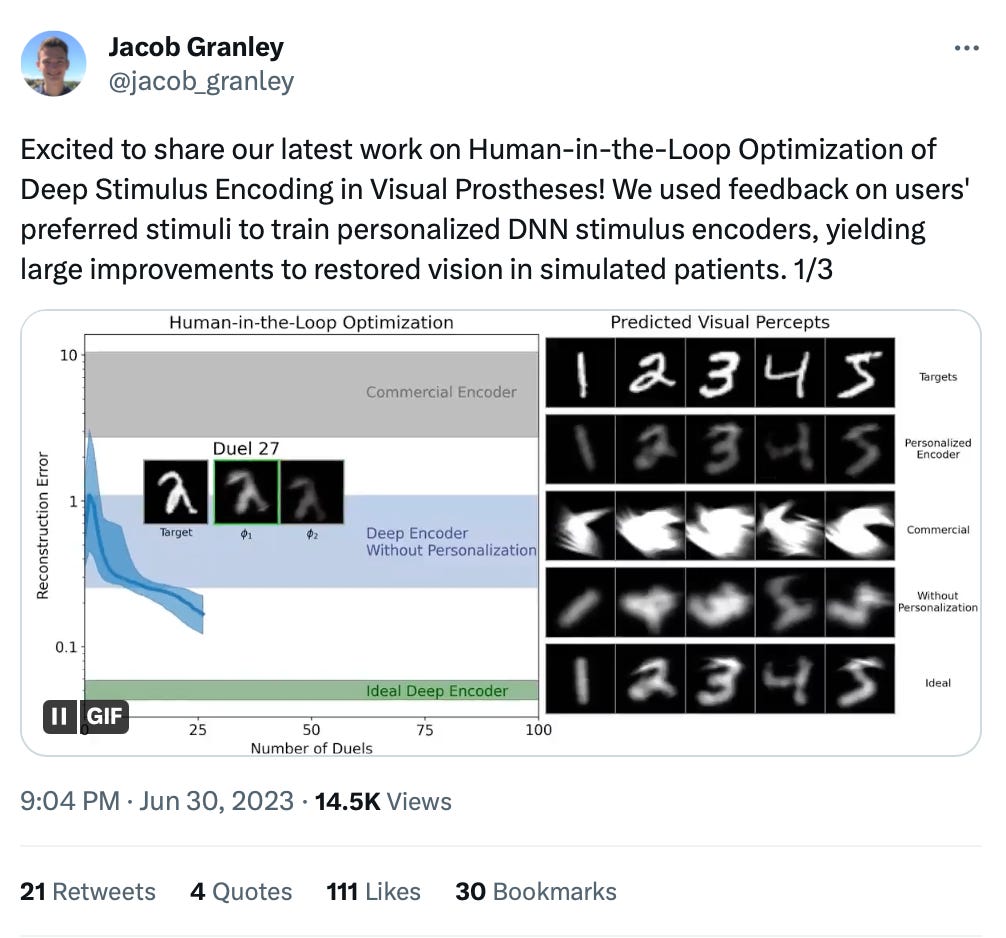
A shared linguistic space for transmitting our thoughts from brain to brain in natural conversations
We recorded cortical activity using ECoG in five dyadic pairs of epilepsy patients during free-form, face-to-face conversations. … We used time-resolved transcriptions of each conversation to extract embeddings for each word from the autoregressive large language model GPT-2, [then] used ridge regression to estimate separate encoding models for the speaker and listener to predict the high-gamma band neural activity for each word using the embeddings from GPT-2.
LLMs provide a new computational framework for learning the shared linguistic code—i.e., the mutual understanding of the meaning of words in context—that humans use to communicate effectively.
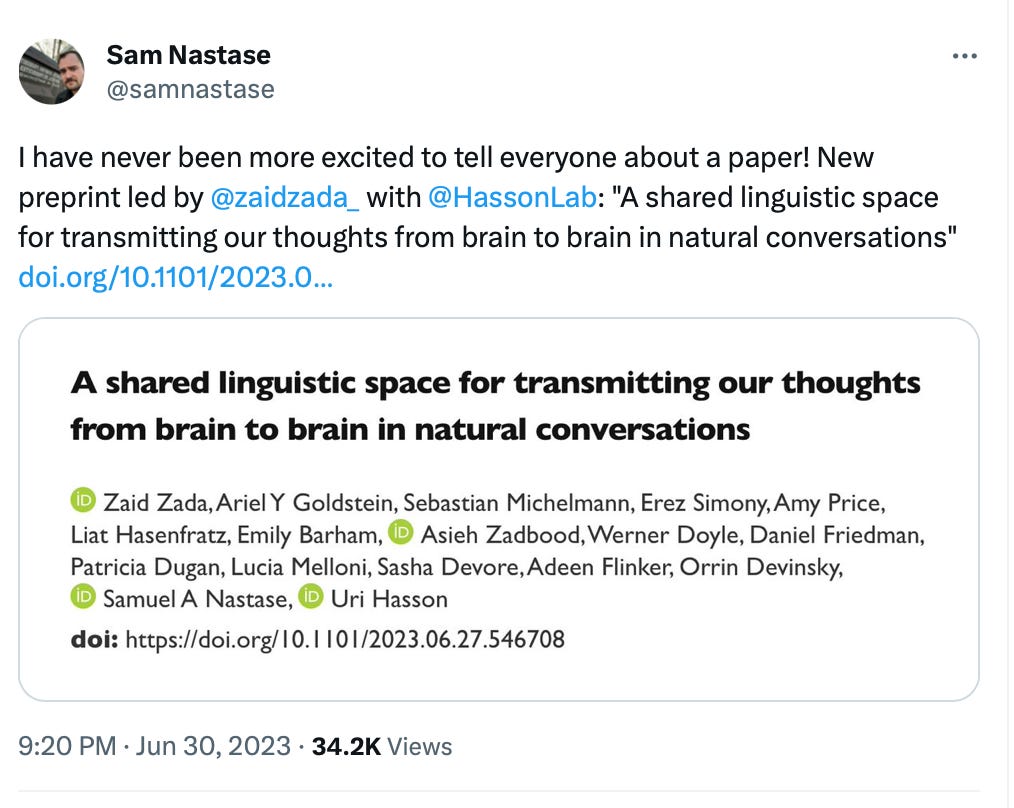
Cinematic Mindscapes: High-quality Video Reconstruction from Brain Activity
In this work, we propose Mind-Video that learns spatiotemporal information from continuous fMRI data of the cerebral cortex progressively through masked brain modeling, multimodal contrastive learning with spatiotemporal attention, and co-training with an augmented Stable Diffusion model that incorporates network temporal inflation.
Peter Zhegin: A co-training with an augmented Stable Diffusion model took place, so I’d watch the space where foundation models overlap with neurotech.
Here is a thread:
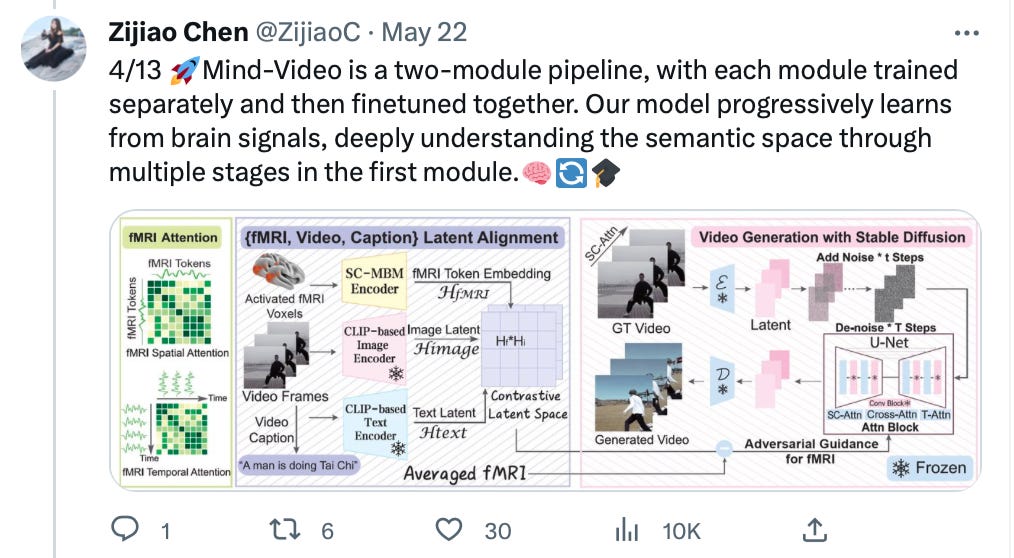
DreamDiffusion: Generating High-Quality Images from Brain EEG Signals
DreamDiffusion for generating high-quality images from EEG signals… Through a pre-training and fine-tuning scheme, EEG data can be encoded to the representation suitable for image generation using Stable Diffusion… Currently, EEG data only provide coarse- grained information at the category level in experimental results.
Peter Zhegin: Another example of using foundation models and using data science to overcome hardware challenges from 1) modality itself - EEG’s inherent variability and noise and 2) variability in end-user devices, e.g. in the experiment devices’ channels ranged from 30 to 128, but the authors uniformly padded all the data to 128 channels by filling missing channels with replicated values.
If you are doing a consumer EEG startup, look at the paper.
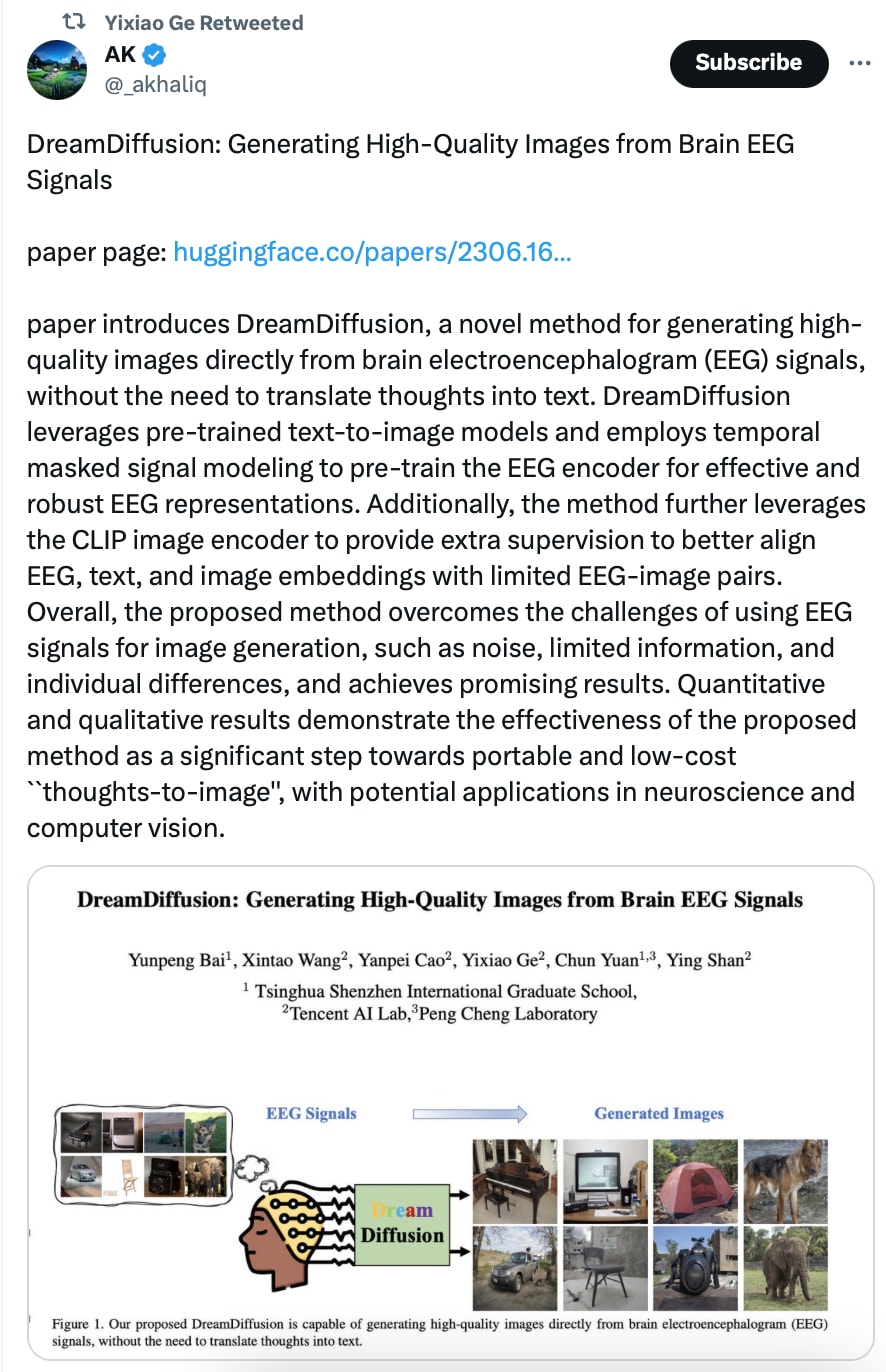
Here is a breakdown of another paper that uses Stable Diffusion but for the fMRI data. And here’s a thread:
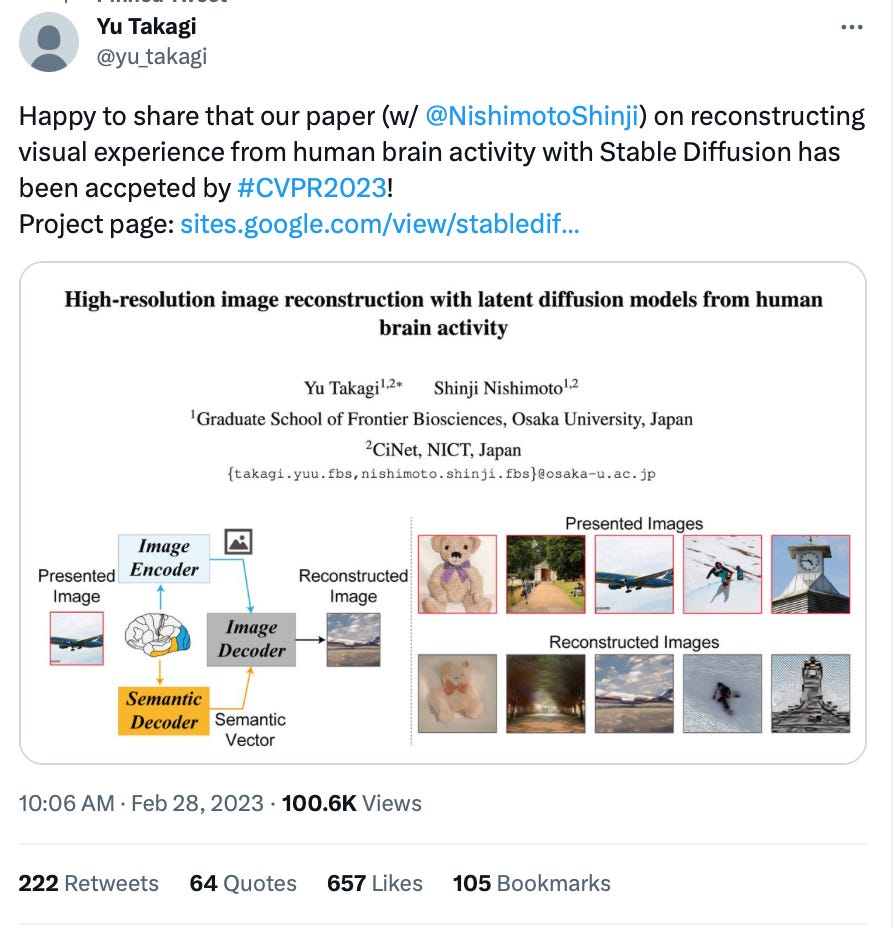
Imagined speech can be decoded from low- and cross-frequency intracranial EEG features
Imagined speech decoding with non-invasive techniques, i.e. surface electroencephalography (EEG) or magnetoencephalography (MEG), has so far not led to convincing results… The most effective approach so far to advance toward a real “imagined speech” decoding system is based on electrocorticographic (ECoG) signals.
In this study, we could probe the representations of imagined speech at various linguistic levels, namely articulatory, phonological, and vocalic. …we reached significant decoding performance using lower frequencies and the phonetic representation level. … the word level, which was mostly used in this study, is presumably not the optimal currency for an efficient imagined speech decoding strategy based on phonetic representations. A realistic BCI will have to offer decoding based on representation space that can span the size of the average human language repertoire.
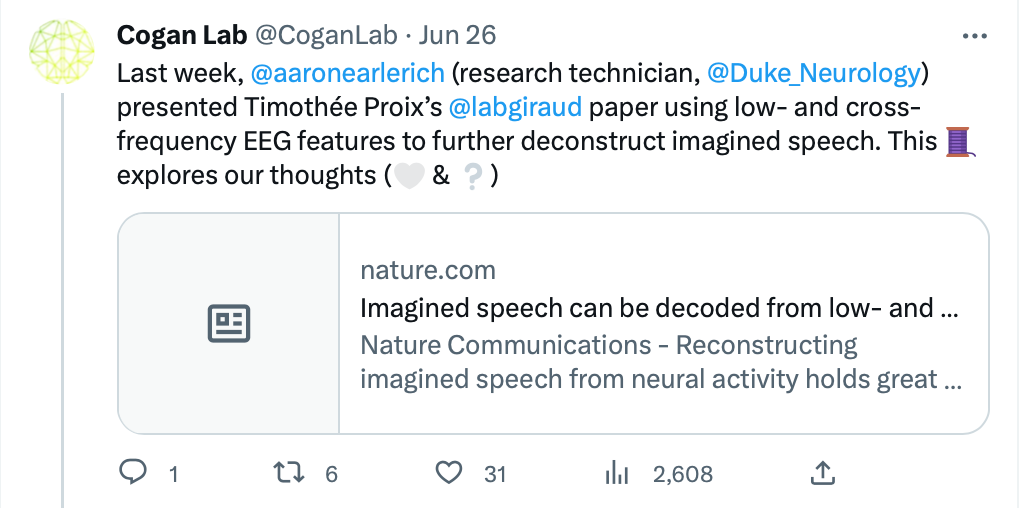
Misc neurotech reading
Effect of breathwork on stress and mental health: A meta-analysis of randomised-controlled trials
This meta-analysis found significant small-medium effects of breathwork on self-reported/subjective stress, anxiety and depression compared to non-breathwork control conditions.
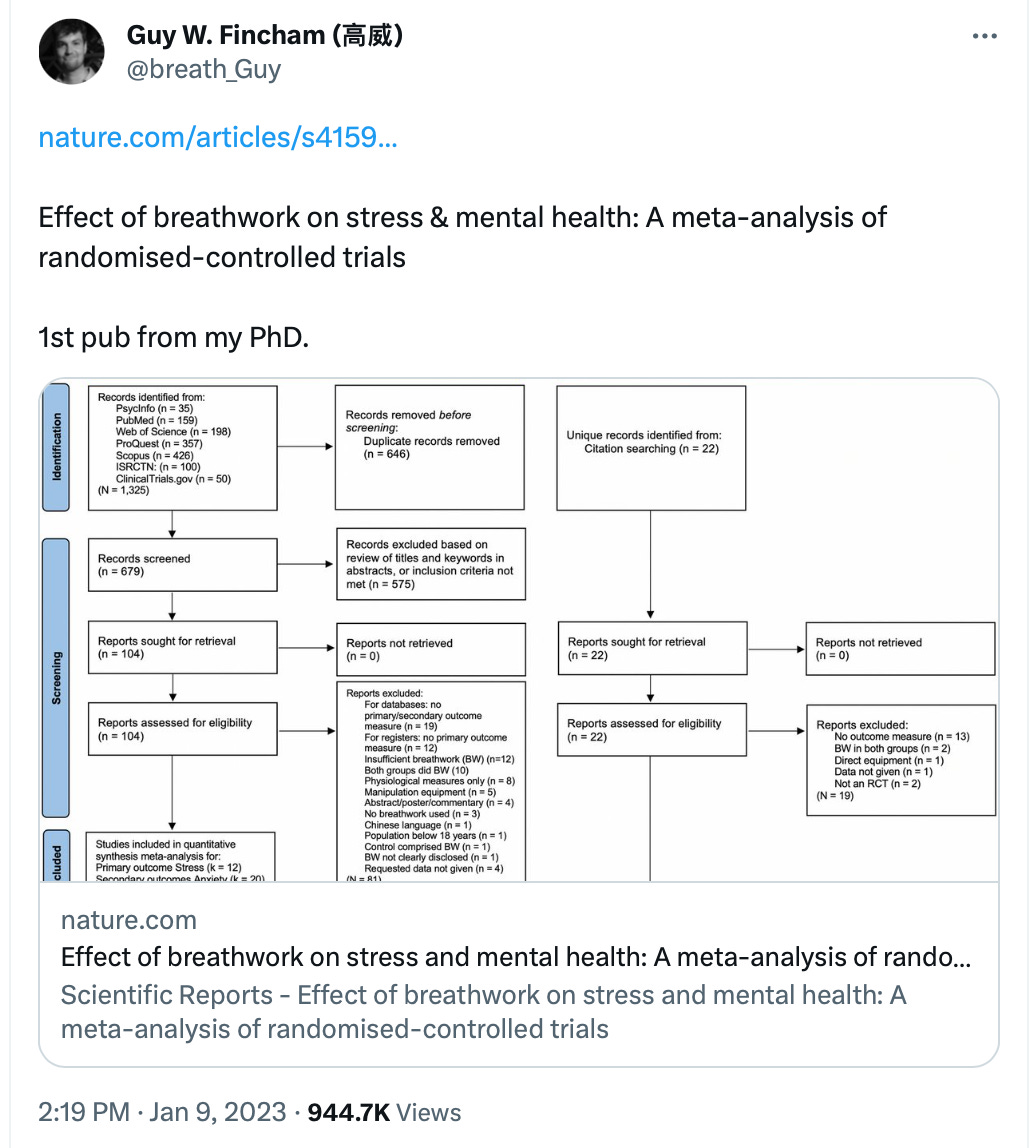
Peter Zhegin: I think neuro app developers underestimate breathwork. While focused on providing tools to control the flow of thoughts, even leading apps provide quite generic tools/exercises for breathing.
Business
Two BCI landscapes, by NeurotechJP and by newfund (full report).
Peter Zhegin: NeurotechJP’s landscape highlights multiple areas/markets for BCIs. Newfund’s landscape brings an exciting framework to structure the ecosystem around applications and market maturity. It also lists some notable transactions.
The NeurotechJP’s landscape:
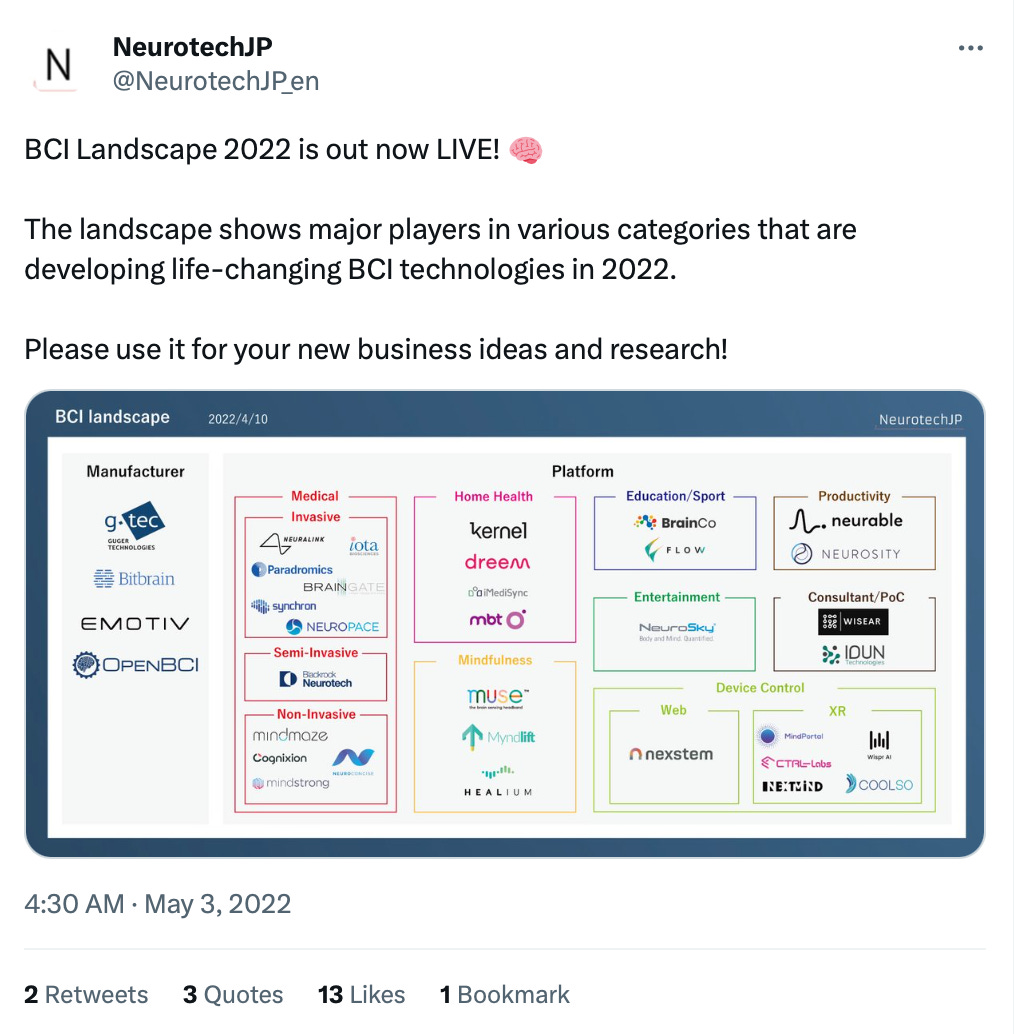
Newfund’s framework by Anne-Sophie Saint-Martin and Constant Beroulle
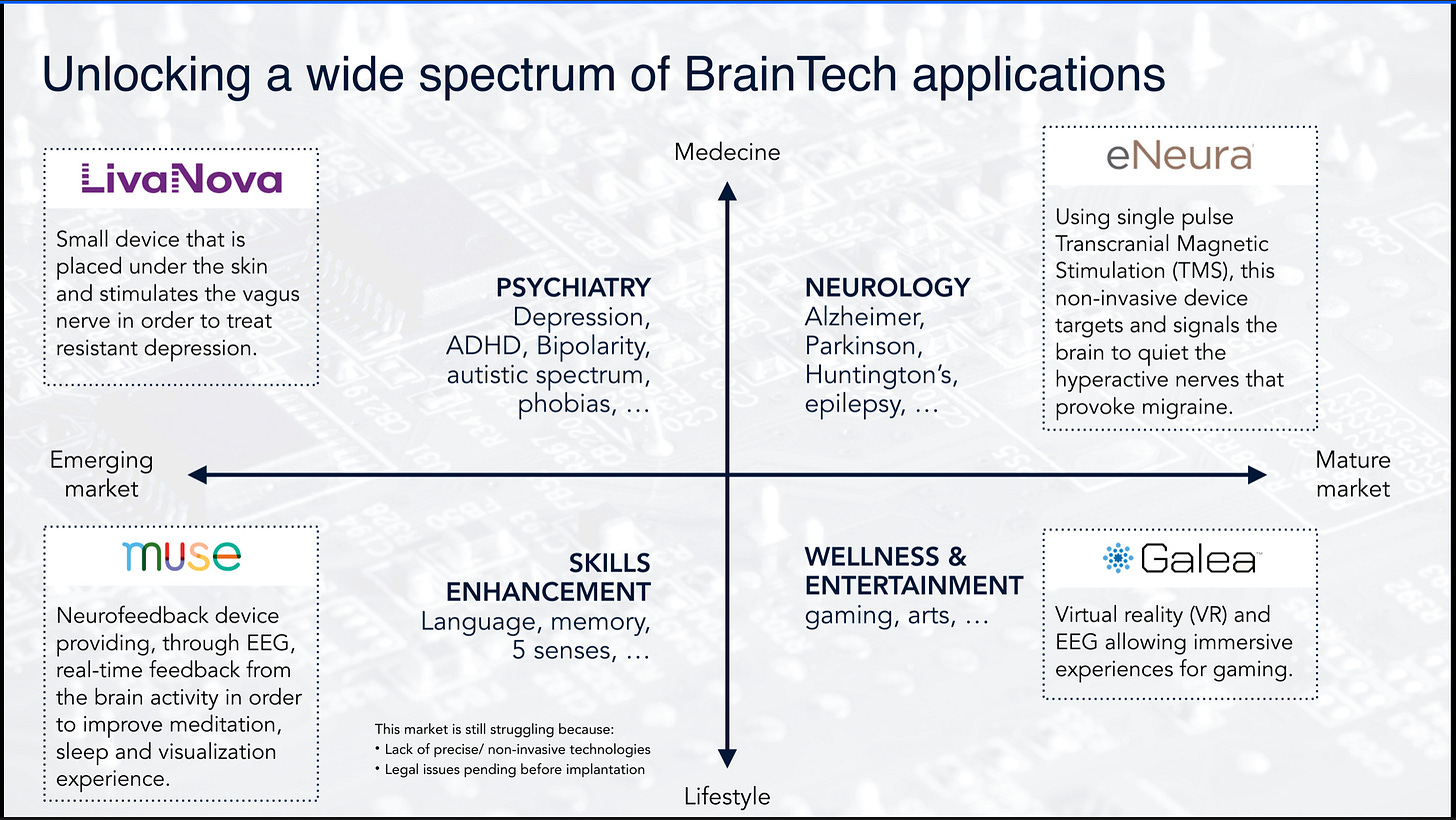
II. Startup/Corporate News
🇬🇧🇨🇭 Babylon to go private, merge with MindMaze. Babylon, a telehealth provider, and MindMaze, a game-like neuro-rehabilitation, therapy and monitoring developer (among other things, experimented with an EEG headset), are about to merge.
Here is a detailed commentary on the transaction from a health tech startup founder Lloyd Pierce. Among other things, it covers products that the combined company is working on, e.g. a digital rehabilitation platform for patients with stroke and a digital platform for patients with Parkinson's disease.
Peter Zhegin: It is probably an example of when longer development cycles, high R&D costs, coupled with long sales cycles in the healthcare segment, and/or a limited market size make the company consider a merger with a business that works with consumers and generates some cash (Babylon offers digital primary care services).
🇺🇸 Paradromics Raises $33 Million in Funding, Achieves Breakthrough Medical Device Designation from FDA. Here is Primemovers Lab, the lead investor, explaining why they have invested and some highlights:
…we firmly believe that high data rate, single neuron signals are essential for any future-oriented platform.
….Their modular design offers unparalleled flexibility, enabling simultaneous decoding of multiple motor areas.
Paradromics has also identified a clear first market opportunity for their platform with high medical need and low clinical risk. Their Connexus DDI will serve as an assistive communication device for people who have lost the ability to speak — constituting a $20B market opportunity in the US alone.
Paradromics’ focus on long-term suitability and adherence to stringent medical device development standards.
Peter Zhegin: A big initial market ($20B), a platform potential/modular design to expand to other markets, breakthrough tech, and long-term suitability. These are the proper ingredients for creating an outstanding company.
Neuralink, which was valued at close to $2 billion in a private fundraising round two years ago, is now worth around $5 billion based on privately executed stock trades… The stock transactions at a valuation of around $5 billion have been carried out by shareholders such as employees and the company's early backers, rather than Neuralink selling new shares to investors.
Peter Zhegin: Frontier tech has longer development cycles compared to software. As a result, it takes longer for companies to reach stages where partial cashouts for founders/early employees are possible (this creates tension, stress, distractions, etc.). Neuralink suggests that it is still possible to get some reward even if a company may need a decade to commercialise its tech.
🇮🇳 Neuphony secures funding to build more brain gyms. Neuphony uses EEG based neurofeedback to monitor brain waves and to recommend meditations.
🇨🇦 NeuroServo Closes $2.2M Funding Round. Ultra-portable devices for ICU & ER with continuous monitoring, real-time brainwave analysis and pathology detection.
🇺🇸 Universal Brain joined an accelerator programme by MedTech Innovator that offers non-dilutive funding for two competition winners. Universal Brain develops an EEG headset, develops neurofeedback and data analytics software.
🇨🇳 BrainThink has raised an angel round. BrainThink integrates wearable sensors to deliver scalp electroencephalogram and heart rate variability.
📬📬📬 Subscribe for a monthly update on neurotech and neurotech investment/commercialisation activity.